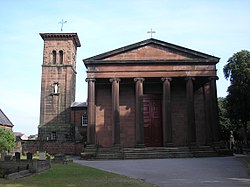| St Bartholomew's Church | |
|---|---|
 Front entrance | |
| 53°24′27″N2°45′03″W / 53.4076°N 2.7509°W | |
| OS grid reference | SJ 50178 90352 |
| Location | Rainhill, Merseyside |
| Country | England |
| Denomination | Roman Catholic |
| History | |
| Status | Active |
| Founder(s) | Bartholomew Bretherton |
| Dedication | Saint Bartholomew |
| Consecrated | 24 August 1840 |
| Architecture | |
| Functional status | Parish church |
| Heritage designation | Grade II listed |
| Designated | 28 January 1971 [1] |
| Architect(s) | Joshua Dawson |
| Groundbreaking | April 1838 |
| Construction cost | £8,000 |
| Administration | |
| Province | Liverpool |
| Archdiocese | Liverpool |
| Deanery | St Helens (St Monica) |
St Bartholomew's Church is a Roman Catholic parish church in Rainhill, Merseyside. It was built in 1838-40 in the style of the Church of San Bartholomew on the Island in Rome. Grade II listed, it is situated on the A57 Warrington Road, opposite Rainhill Hall and was described by Nikolaus Pevsner as 'The noblest Catholic church in South Lancashire'. [2]




